service CHEVROLET DURAMAX 2006 Owners Manual
[x] Cancel search | Manufacturer: CHEVROLET, Model Year: 2006, Model line: DURAMAX, Model: CHEVROLET DURAMAX 2006Pages: 100, PDF Size: 0.71 MB
Page 1 of 100
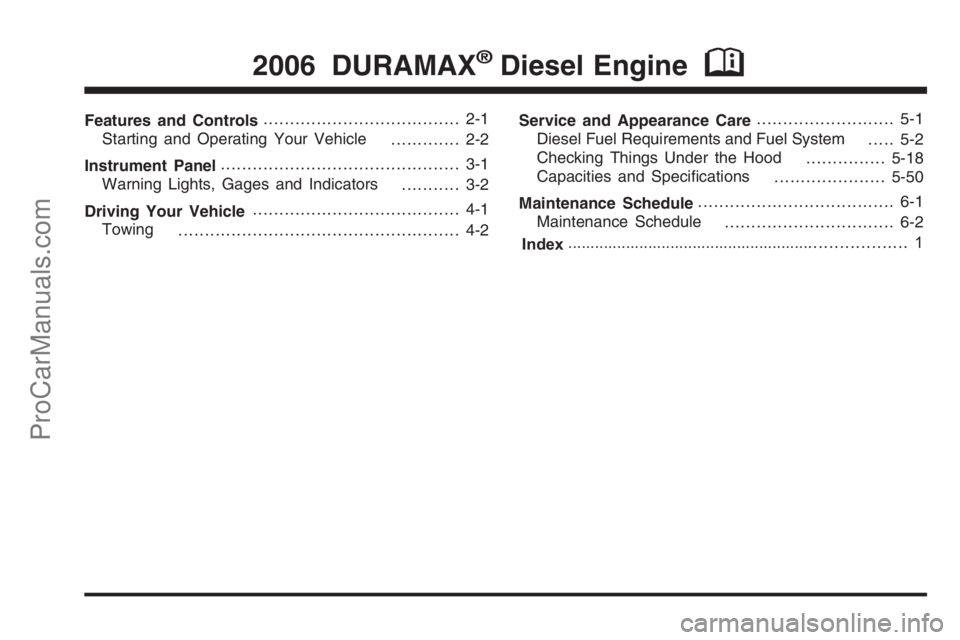
Features and Controls..................................... 2-1
Starting and Operating Your Vehicle ............. 2-2
Instrument Panel ............................................. 3-1
Warning Lights, Gages and Indicators ........... 3-2
Driving Your Vehicle ....................................... 4-1
Towing ..................................................... 4-2 Service and Appearance Care
.......................... 5-1
Diesel Fuel Requirements and Fuel System ..... 5-2
Checking Things Under the Hood ...............5-18
Capacities and Specifications .....................5-50
Maintenance Schedule ..................................... 6-1
Maintenance Schedule ................................ 6-2
2006 DURAMAX®Diesel EngineM
Index ......................................................................... 1
ProCarManuals.com
Page 4 of 100
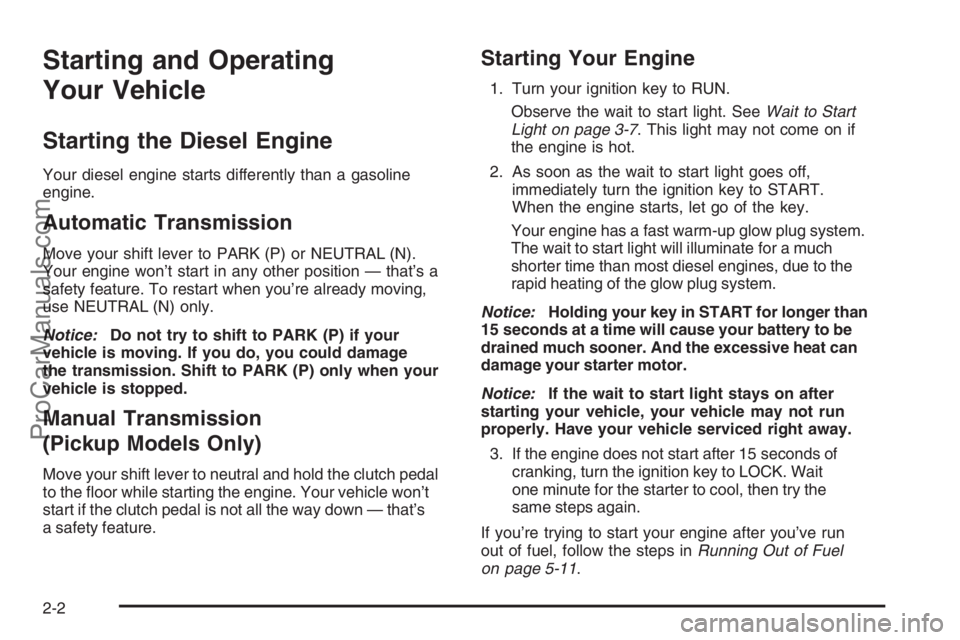
Starting and Operating
Your Vehicle
Starting the Diesel Engine
Your diesel engine starts differently than a gasoline
engine.
Automatic Transmission
Move your shift lever to PARK (P) or NEUTRAL (N).
Your engine won’t start in any other position — that’s a
safety feature. To restart when you’re already moving,
use NEUTRAL (N) only.
Notice:Do not try to shift to PARK (P) if your
vehicle is moving. If you do, you could damage
the transmission. Shift to PARK (P) only when your
vehicle is stopped.
Manual Transmission
(Pickup Models Only)
Move your shift lever to neutral and hold the clutch pedal
to the floor while starting the engine. Your vehicle won’t
start if the clutch pedal is not all the way down — that’s
a safety feature.
Starting Your Engine
1. Turn your ignition key to RUN.
Observe the wait to start light. SeeWait to Start
Light on page 3-7. This light may not come on if
the engine is hot.
2. As soon as the wait to start light goes off,
immediately turn the ignition key to START.
When the engine starts, let go of the key.
Your engine has a fast warm-up glow plug system.
The wait to start light will illuminate for a much
shorter time than most diesel engines, due to the
rapid heating of the glow plug system.
Notice:Holding your key in START for longer than
15 seconds at a time will cause your battery to be
drained much sooner. And the excessive heat can
damage your starter motor.
Notice:If the wait to start light stays on after
starting your vehicle, your vehicle may not run
properly. Have your vehicle serviced right away.
3. If the engine does not start after 15 seconds of
cranking, turn the ignition key to LOCK. Wait
one minute for the starter to cool, then try the
same steps again.
If you’re trying to start your engine after you’ve run
out of fuel, follow the steps inRunning Out of Fuel
on page 5-11.
2-2
ProCarManuals.com
Page 5 of 100
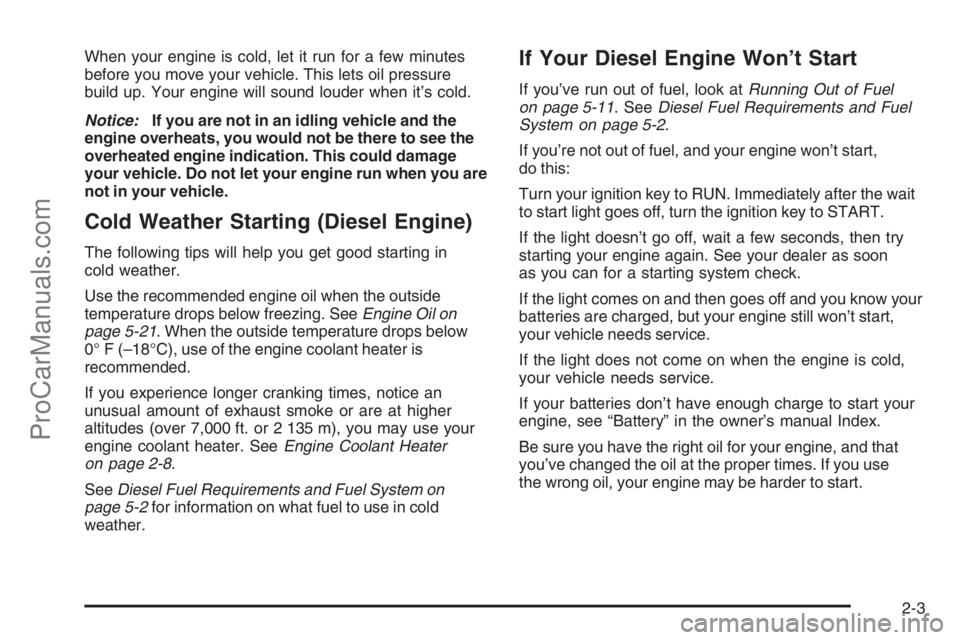
When your engine is cold, let it run for a few minutes
before you move your vehicle. This lets oil pressure
build up. Your engine will sound louder when it’s cold.
Notice:If you are not in an idling vehicle and the
engine overheats, you would not be there to see the
overheated engine indication. This could damage
your vehicle. Do not let your engine run when you are
not in your vehicle.
Cold Weather Starting (Diesel Engine)
The following tips will help you get good starting in
cold weather.
Use the recommended engine oil when the outside
temperature drops below freezing. SeeEngine Oil on
page 5-21. When the outside temperature drops below
0° F (–18°C), use of the engine coolant heater is
recommended.
If you experience longer cranking times, notice an
unusual amount of exhaust smoke or are at higher
altitudes (over 7,000 ft. or 2 135 m), you may use your
engine coolant heater. SeeEngine Coolant Heater
on page 2-8.
SeeDiesel Fuel Requirements and Fuel System on
page 5-2for information on what fuel to use in cold
weather.
If Your Diesel Engine Won’t Start
If you’ve run out of fuel, look atRunning Out of Fuel
on page 5-11. SeeDiesel Fuel Requirements and Fuel
System on page 5-2.
If you’re not out of fuel, and your engine won’t start,
do this:
Turn your ignition key to RUN. Immediately after the wait
to start light goes off, turn the ignition key to START.
If the light doesn’t go off, wait a few seconds, then try
starting your engine again. See your dealer as soon
as you can for a starting system check.
If the light comes on and then goes off and you know your
batteries are charged, but your engine still won’t start,
your vehicle needs service.
If the light does not come on when the engine is cold,
your vehicle needs service.
If your batteries don’t have enough charge to start your
engine, see “Battery” in the owner’s manual Index.
Be sure you have the right oil for your engine, and that
you’ve changed the oil at the proper times. If you use
the wrong oil, your engine may be harder to start.
2-3
ProCarManuals.com
Page 6 of 100
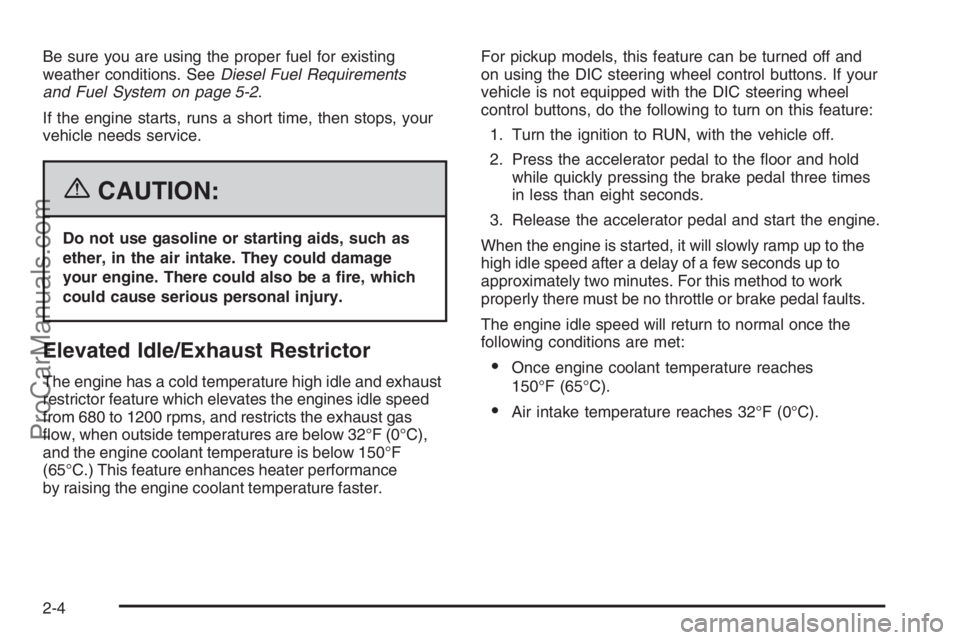
Be sure you are using the proper fuel for existing
weather conditions. SeeDiesel Fuel Requirements
and Fuel System on page 5-2.
If the engine starts, runs a short time, then stops, your
vehicle needs service.
{CAUTION:
Do not use gasoline or starting aids, such as
ether, in the air intake. They could damage
your engine. There could also be a �re, which
could cause serious personal injury.
Elevated Idle/Exhaust Restrictor
The engine has a cold temperature high idle and exhaust
restrictor feature which elevates the engines idle speed
from 680 to 1200 rpms, and restricts the exhaust gas
flow, when outside temperatures are below 32°F (0°C),
and the engine coolant temperature is below 150°F
(65°C.) This feature enhances heater performance
by raising the engine coolant temperature faster.For pickup models, this feature can be turned off and
on using the DIC steering wheel control buttons. If your
vehicle is not equipped with the DIC steering wheel
control buttons, do the following to turn on this feature:
1. Turn the ignition to RUN, with the vehicle off.
2. Press the accelerator pedal to the floor and hold
while quickly pressing the brake pedal three times
in less than eight seconds.
3. Release the accelerator pedal and start the engine.
When the engine is started, it will slowly ramp up to the
high idle speed after a delay of a few seconds up to
approximately two minutes. For this method to work
properly there must be no throttle or brake pedal faults.
The engine idle speed will return to normal once the
following conditions are met:•Once engine coolant temperature reaches
150°F (65°C).
•Air intake temperature reaches 32°F (0°C).
2-4
ProCarManuals.com
Page 16 of 100
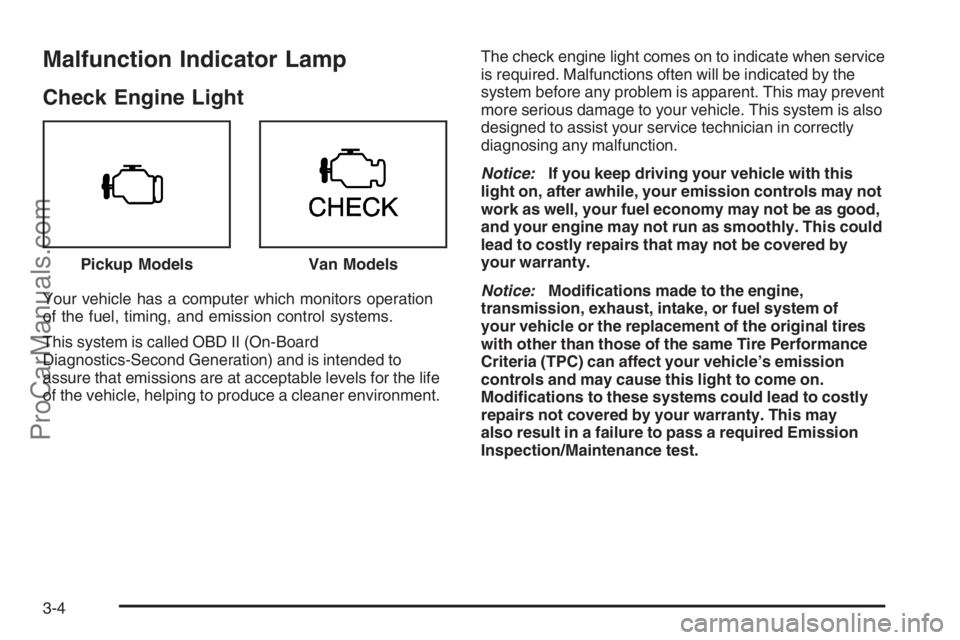
Malfunction Indicator Lamp
Check Engine Light
Your vehicle has a computer which monitors operation
of the fuel, timing, and emission control systems.
This system is called OBD II (On-Board
Diagnostics-Second Generation) and is intended to
assure that emissions are at acceptable levels for the life
of the vehicle, helping to produce a cleaner environment.The check engine light comes on to indicate when service
is required. Malfunctions often will be indicated by the
system before any problem is apparent. This may prevent
more serious damage to your vehicle. This system is also
designed to assist your service technician in correctly
diagnosing any malfunction.
Notice:If you keep driving your vehicle with this
light on, after awhile, your emission controls may not
work as well, your fuel economy may not be as good,
and your engine may not run as smoothly. This could
lead to costly repairs that may not be covered by
your warranty.
Notice:Modi�cations made to the engine,
transmission, exhaust, intake, or fuel system of
your vehicle or the replacement of the original tires
with other than those of the same Tire Performance
Criteria (TPC) can affect your vehicle’s emission
controls and may cause this light to come on.
Modi�cations to these systems could lead to costly
repairs not covered by your warranty. This may
also result in a failure to pass a required Emission
Inspection/Maintenance test. Pickup Models
Van Models
3-4
ProCarManuals.com
Page 17 of 100
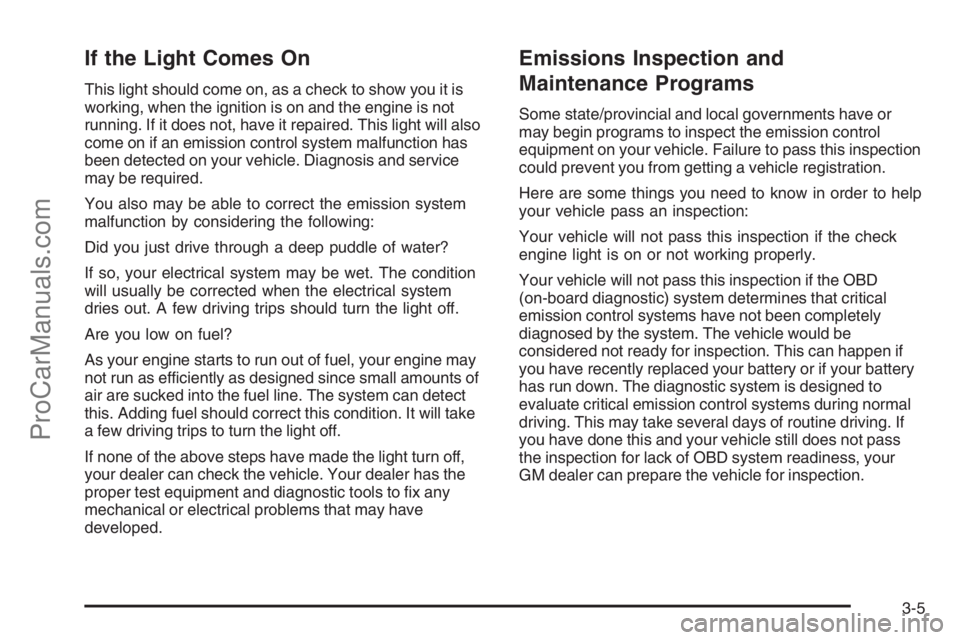
If the Light Comes On
This light should come on, as a check to show you it is
working, when the ignition is on and the engine is not
running. If it does not, have it repaired. This light will also
come on if an emission control system malfunction has
been detected on your vehicle. Diagnosis and service
may be required.
You also may be able to correct the emission system
malfunction by considering the following:
Did you just drive through a deep puddle of water?
If so, your electrical system may be wet. The condition
will usually be corrected when the electrical system
dries out. A few driving trips should turn the light off.
Are you low on fuel?
As your engine starts to run out of fuel, your engine may
not run as efficiently as designed since small amounts of
air are sucked into the fuel line. The system can detect
this. Adding fuel should correct this condition. It will take
a few driving trips to turn the light off.
If none of the above steps have made the light turn off,
your dealer can check the vehicle. Your dealer has the
proper test equipment and diagnostic tools to fix any
mechanical or electrical problems that may have
developed.
Emissions Inspection and
Maintenance Programs
Some state/provincial and local governments have or
may begin programs to inspect the emission control
equipment on your vehicle. Failure to pass this inspection
could prevent you from getting a vehicle registration.
Here are some things you need to know in order to help
your vehicle pass an inspection:
Your vehicle will not pass this inspection if the check
engine light is on or not working properly.
Your vehicle will not pass this inspection if the OBD
(on-board diagnostic) system determines that critical
emission control systems have not been completely
diagnosed by the system. The vehicle would be
considered not ready for inspection. This can happen if
you have recently replaced your battery or if your battery
has run down. The diagnostic system is designed to
evaluate critical emission control systems during normal
driving. This may take several days of routine driving. If
you have done this and your vehicle still does not pass
the inspection for lack of OBD system readiness, your
GM dealer can prepare the vehicle for inspection.
3-5
ProCarManuals.com
Page 18 of 100
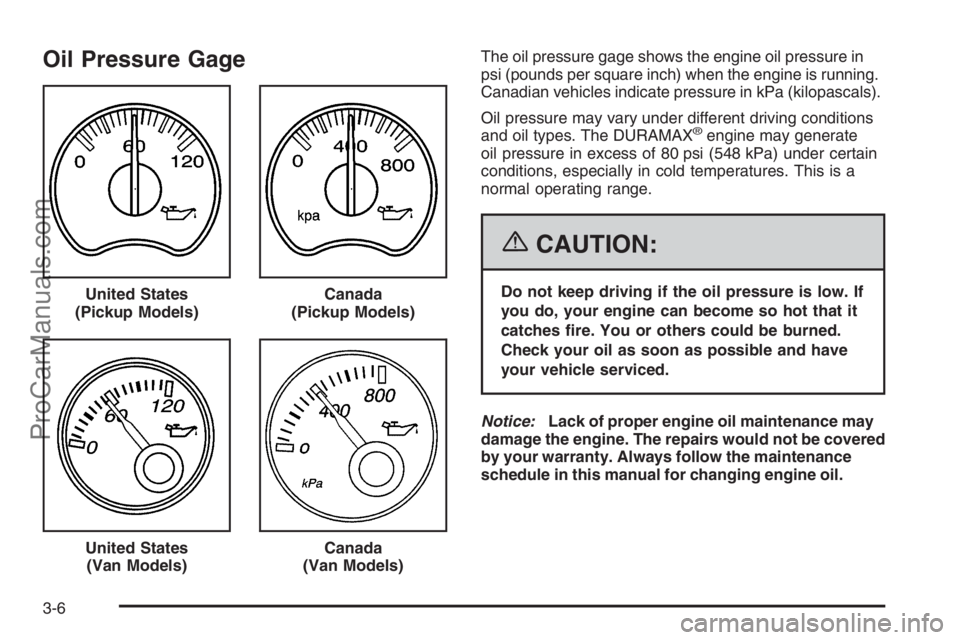
Oil Pressure GageThe oil pressure gage shows the engine oil pressure in
psi (pounds per square inch) when the engine is running.
Canadian vehicles indicate pressure in kPa (kilopascals).
Oil pressure may vary under different driving conditions
and oil types. The DURAMAX
®engine may generate
oil pressure in excess of 80 psi (548 kPa) under certain
conditions, especially in cold temperatures. This is a
normal operating range.
{CAUTION:
Do not keep driving if the oil pressure is low. If
you do, your engine can become so hot that it
catches �re. You or others could be burned.
Check your oil as soon as possible and have
your vehicle serviced.
Notice:Lack of proper engine oil maintenance may
damage the engine. The repairs would not be covered
by your warranty. Always follow the maintenance
schedule in this manual for changing engine oil. United States
(Pickup Models)Canada
(Pickup Models)
United States
(Van Models)Canada
(Van Models)
3-6
ProCarManuals.com
Page 19 of 100
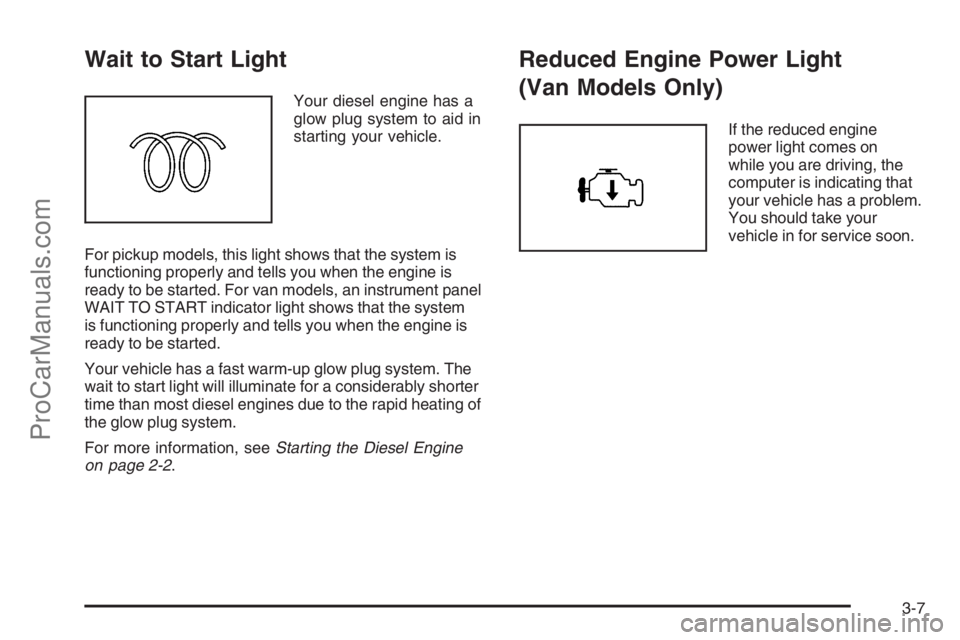
Wait to Start Light
Your diesel engine has a
glow plug system to aid in
starting your vehicle.
For pickup models, this light shows that the system is
functioning properly and tells you when the engine is
ready to be started. For van models, an instrument panel
WAIT TO START indicator light shows that the system
is functioning properly and tells you when the engine is
ready to be started.
Your vehicle has a fast warm-up glow plug system. The
wait to start light will illuminate for a considerably shorter
time than most diesel engines due to the rapid heating of
the glow plug system.
For more information, seeStarting the Diesel Engine
on page 2-2.
Reduced Engine Power Light
(Van Models Only)
If the reduced engine
power light comes on
while you are driving, the
computer is indicating that
your vehicle has a problem.
You should take your
vehicle in for service soon.
3-7
ProCarManuals.com
Page 21 of 100
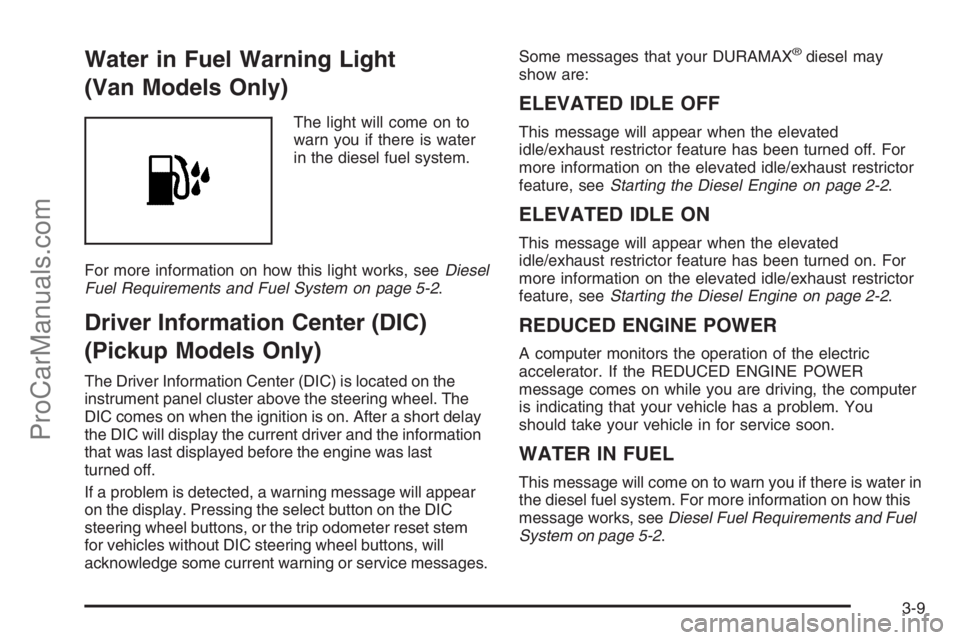
Water in Fuel Warning Light
(Van Models Only)
The light will come on to
warn you if there is water
in the diesel fuel system.
For more information on how this light works, seeDiesel
Fuel Requirements and Fuel System on page 5-2.
Driver Information Center (DIC)
(Pickup Models Only)
The Driver Information Center (DIC) is located on the
instrument panel cluster above the steering wheel. The
DIC comes on when the ignition is on. After a short delay
the DIC will display the current driver and the information
that was last displayed before the engine was last
turned off.
If a problem is detected, a warning message will appear
on the display. Pressing the select button on the DIC
steering wheel buttons, or the trip odometer reset stem
for vehicles without DIC steering wheel buttons, will
acknowledge some current warning or service messages.Some messages that your DURAMAX
®diesel may
show are:
ELEVATED IDLE OFF
This message will appear when the elevated
idle/exhaust restrictor feature has been turned off. For
more information on the elevated idle/exhaust restrictor
feature, seeStarting the Diesel Engine on page 2-2.
ELEVATED IDLE ON
This message will appear when the elevated
idle/exhaust restrictor feature has been turned on. For
more information on the elevated idle/exhaust restrictor
feature, seeStarting the Diesel Engine on page 2-2.
REDUCED ENGINE POWER
A computer monitors the operation of the electric
accelerator. If the REDUCED ENGINE POWER
message comes on while you are driving, the computer
is indicating that your vehicle has a problem. You
should take your vehicle in for service soon.
WATER IN FUEL
This message will come on to warn you if there is water in
the diesel fuel system. For more information on how this
message works, seeDiesel Fuel Requirements and Fuel
System on page 5-2.
3-9
ProCarManuals.com
Page 25 of 100
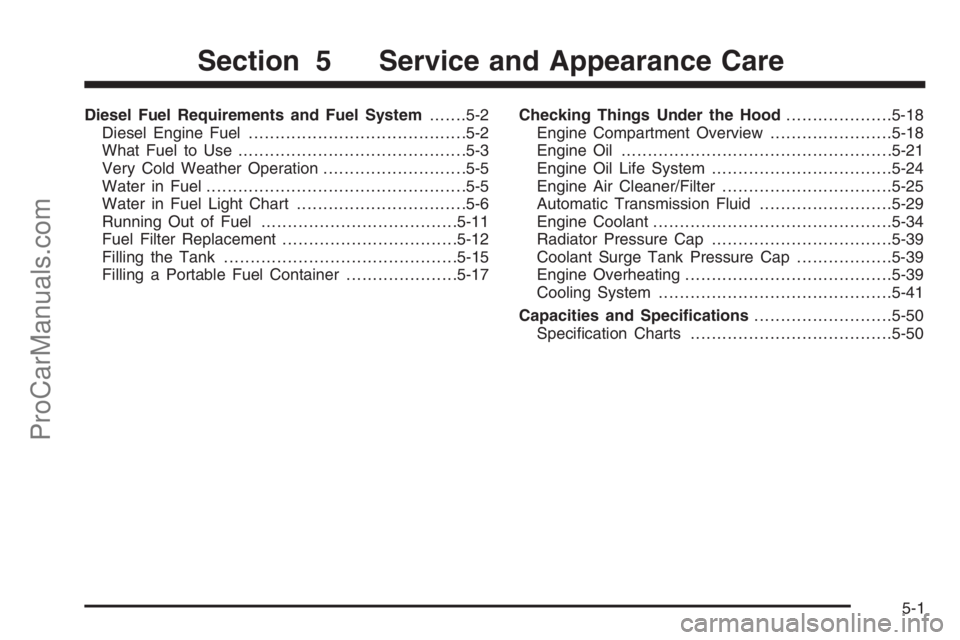
Diesel Fuel Requirements and Fuel System.......5-2
Diesel Engine Fuel.........................................5-2
What Fuel to Use...........................................5-3
Very Cold Weather Operation...........................5-5
Water in Fuel.................................................5-5
Water in Fuel Light Chart................................5-6
Running Out of Fuel.....................................5-11
Fuel Filter Replacement.................................5-12
Filling the Tank............................................5-15
Filling a Portable Fuel Container.....................5-17Checking Things Under the Hood....................5-18
Engine Compartment Overview.......................5-18
Engine Oil...................................................5-21
Engine Oil Life System..................................5-24
Engine Air Cleaner/Filter................................5-25
Automatic Transmission Fluid.........................5-29
Engine Coolant.............................................5-34
Radiator Pressure Cap..................................5-39
Coolant Surge Tank Pressure Cap..................5-39
Engine Overheating.......................................5-39
Cooling System............................................5-41
Capacities and Speci�cations..........................5-50
Specification Charts......................................5-50
Section 5 Service and Appearance Care
5-1
ProCarManuals.com